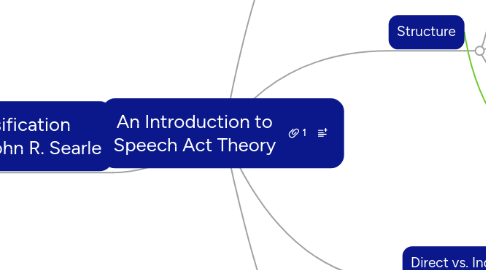
1. Classification by John R. Searle
1.1. Declarations
1.1.1. To change an existing state of affairs by declaring something
1.1.2. e.g. to fire
1.1.3. e.g. to baptize
1.1.4. e.g. to arrest
1.2. Representatives
1.2.1. To represent or assert a state of affairs as it is viewed by the speaker
1.2.2. e.g.to assert
1.2.3. e.g. to claim
1.2.4. e.g. to complain
1.3. Expressives
1.3.1. To express feelings and speakers' inner states
1.3.2. e.g. to compliment
1.3.3. e.g. to thank
1.3.4. e.g. to congratulate
1.4. Directives
1.4.1. To direct hearers to do something
1.4.2. e.g. to ask
1.4.3. e.g. to order
1.4.4. e.g. to permit
1.5. Commissives
1.5.1. The speaker commits himself to a certain action in the future
1.5.2. e.g. to promise
1.5.3. e.g. to vow
1.5.4. e.g. to swear
1.6. Combinations
1.6.1. Some speech acts can't be assigned to one particular type, but are combinations of two different types
1.6.2. e.g. "One more step, and I'll call the police!"
2. Locution, Illocution, Perlocution
2.1. Locution
2.1.1. refers to the linguistic form of a speech act
2.1.2. Locutionary act = what we say
2.2. Illocution
2.2.1. refers to the communicative intention
2.2.2. Illocutionary force = what we mean by it
2.3. Perlocution
2.3.1. refers to the effect produced on the hearer
2.3.2. Perlocutionary effect = the effect it has
2.4. Example
2.4.1. Locution: "What a gorgeous dress!"
2.4.2. Illocution: "Mom, can I have it?" / "Can I borrow it?" / Compliment
2.4.3. Perlocution: Your mom buys the dress for you / Your friend hands it over to you / "Thank you for the compliment"
3. Structure
3.1. Interrogative
3.1.1. Function: Question
3.2. Imperative
3.2.1. Function: Command / Request
3.3. Declarative
3.3.1. Function: Statement
4. Direct vs. Indirect Speech Acts
4.1. If structure is used to perform function other than its designated one, the result is an indirect speech act.
4.2. Direct speech act often feature performative verbs
4.2.1. e.g. promise
4.2.2. e.g. claim
4.2.3. e.g. warn
4.3. Indirect speech acts require the hearer to infer the illocutionary act from context, on basis of operative principle, background knowledge etc.
5. Grice's cooperative principle
5.1. Maxim of Quantity
5.1.1. Say neither more nor less than required.
5.2. Maxim of Quality
5.2.1. Do not lie or state for which you lack adequate evidence.
5.3. Maxim of Relation
5.3.1. Be relevant.
5.4. Maxim of Manner
5.4.1. Be clear, brief and orderly.

